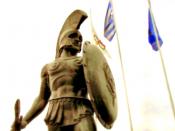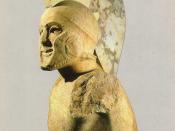The 300 Spartans is a 1962 Cinemascope film depicting the Battle of Thermopylae between the Greek Spartans, and the Persian invading army led by King Xerxes which took place around 480 B.C.E.
The film, ÃÂThe 300 SpartansÃÂ depicts the Greek Spartans as the stuff of legend. That is, through superior weaponry, armor and tactics (the famed Greek Hoplite phalanx), combined with the narrow pass of Thermopylae, enabled the small amount of Greek Spartan warriors (i.e. 300 total) to repel several frontal Persian assaults for three days even though the Persians (As reported by the ancient Greek historian, Herodotus) outnumbered the Spartans with a combined strength of supposedly two and a half million men. The films central thesis and moral is that although the Spartans lost the battle, they won the war because they were free men fighting against a tyrant and displayed such valor in doing so, that all of Greek would unite and follow suit, crushing the Persian army advance in Greece.
The film begins with a council of Greek city states (known as Polis) in Corinth, where the Athenian statesman Themistocles pressed hard to coalesce the rest of the Greek city-states into a united Greek defense against the tyrannical rule of the Persians, thus solidifying the films underlying premise of free men versus tyrannical slavery.
Themistocles is successful in enlisting the help of Sparta, by convincing the Spartan king, Leonidas, that if he were to lead his warriors into battle, the rest of Greece would follow. Leonidas and Themistocles quickly devise a plan to thwart the PersianÃÂs vast armies by using a geographically defensible position, known as Thermopylae, where the vast numbers of the PersianÃÂs armies are negated by the narrow pass through the mountains and into central Greece.
However, because the Spartans are a very...


